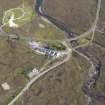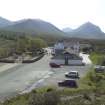Scheduled Maintenance
Please be advised that this website will undergo scheduled maintenance on the following dates: •
Tuesday 3rd December 11:00-15:00
During these times, some services may be temporarily unavailable. We apologise for any inconvenience this may cause.
Skye, Sligachan Hotel
Hotel (Period Unassigned), Inn (Period Unassigned)
Site Name Skye, Sligachan Hotel
Classification Hotel (Period Unassigned), Inn (Period Unassigned)
Canmore ID 99422
Site Number NG42NE 6
NGR NG 48536 29856
Datum OSGB36 - NGR
Permalink http://canmore.org.uk/site/99422
- Council Highland
- Parish Bracadale
- Former Region Highland
- Former District Skye And Lochalsh
- Former County Inverness-shire
Sligachan Hotel, 1830s and later This former droving inn, which replaced an earlier inn at the head of the Loch (ruins still visible), was built near a place where the river could be forded and the new Portree and Dunvegan roads converged. It was the site of an important cattle market from 1794, while later in the 19th century the hotel assumed a significant role in the emergence of Scottish mountaineering. The original droving inn, now partly obscured by a long sun porch across the front, is still visible at the centre; later additions include a wing to the right by John Mackenzie, 1879, and a taller 1930s range on the left.
[Even the disillusioned Pennells thought the Sligachan Hotel a 'swell' place in 1888, 'full of immaculately dressed young ladies and young Oxford men, all with their knickerbockers at the same degree of bagginess, their stockings turned down at the same angle ... The talk was all of hotels and lochs and glens and travels. How long have you been in Skye? Is this your first visit? Did you come by Loch Maree? At what hotel did you stay in Oban?'.]
[In 1805-6 Cumming surveyed Skye for a road system that was constructed between 1807 and 1826. By 1819 Robert Southey could write of Skye '... an hundred miles of road have been made by the commissioners. To hear of such roads in such a country, and to find them in the wild western Highlands is so surprizing, everything else being in so rude a state, that their utility, or at least their necessity, might be doubted, if half the expence were not raised by voluntary taxation'.]
Taken from "Western Seaboard: An Illustrated Architectural Guide", by Mary Miers, 2007. Published by the Rutland Press http://www.rias.org.uk

















